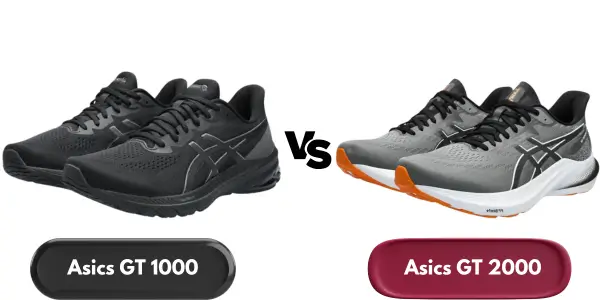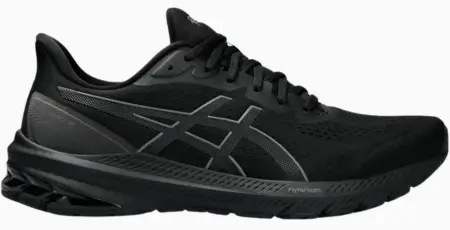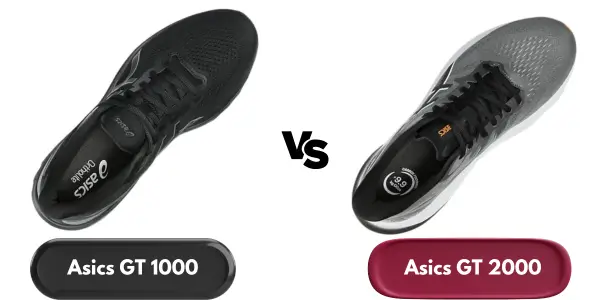Asics GT 1000 vs 2000 Running Shoes Comparison
Last Updated: January 01, 2025 | Author: Jake Thompson
The ASICS GT 1000 and 2000 models have gained attention in the running community, reflecting the brand's rising popularity. As an overpronator in search of stability and comfort, I've tested both shoes extensively. The GT 1000 12 offers reliable performance at a great value, while the GT 2000 12, priced higher, boasts more advanced features. Through rigorous road and track trials, I aim to distinguish between these two ASICS options to help runners find the best match for their unique needs.

This article will compare Asics GT 1000 vs 2000 to help runners with a penchant for stability and comfort choose the best option for their unique running needs.
Table of Contents:
- Key Takeaways
- Table: Asics GT 1000 vs 2000
- Pros & Cons
- Design and Technology
- Upper Construction
- Midsole Differences
- Performance
- Stability and Support
- Comfort and Cushioning
- Durability and Traction
- Fit and Sizing
- Final Verdict
- Frequently Asked Questions
Key Takeaways
- - ASICS GT-1000 is an entry-level stability shoe with a budget price, while ASICS GT-2000 is a mid-range stability shoe with moderate support and a moderate price.
- - GT 1000 has a FlyteFoam midsole, while GT 2000 has a FlyteFoamFF Blast midsole. GT 2000 has a more forgiving midsole, better suited for longer runs above 10km.
- - GT 1000 has a comfortable and flexible engineered mesh upper, while GT 2000 is made from a light and breathable engineered mesh that looks and feels more expensive. GT 2000 has a narrow fit and may require going up a half size or getting the wide version for non-narrow feet.
Table: Asics GT 1000 vs 2000

|

|
|
|---|---|---|
| Feature | ASICS GT 1000 12 | ASICS GT 2000 12 |
| Terrain | Road | Road |
| Pace | Daily running | Daily running |
| Toebox | Wide | Medium |
| Pronation | Overpronation | Overpronation |
| Cushioning | Plush | Balanced |
| All-day wear | ✓ | ✓ |
| For beginners | ✓ | ✓ |
| Jogging | ✓ | ✓ |
| Treadmill | ✓ | - |
| Walking | ✓ | ✓ |
| Arch support | Stability | Stability |
| Heel-to-toe drop | 8 mm | 8 mm |
| Weight | 269g | 266g |
| Widths available | Normal, Wide, X-Wide | Narrow, Normal, Wide, X-Wide |
| Orthotic friendly | ✓ | ✓ |
| Removable insole | ✓ | ✓ |
| Sustainable | - | ✓ |
| Breathable | ✓ | - |
| Comfortable | ✓ | ✓ |
| Maximalist | ✓ | ✓ |
| Distance | Long distance | Long distance |
| Foot Condition | Plantar fasciitis, Flat feet | Plantar fasciitis, Flat feet |
| Strike Pattern | Forefoot/Midfoot strike | Heel strike |
| Flexibility | Very flexible | Moderate |
| Arch Type | Low arch | Low arch |
| Material | Mesh | Mesh |
| Number of colorways | 32 | 46 |
| Forefoot height | 22mm | 26.5mm |
| Heel height | 30mm | 34.5mm |
| Price |
Pros & Cons
Asics GT 1000 12
Pros:- - More affordable
- - Very stable
- - Durable outsole
- - Less cushioning
- - Fewer premium features
Asics GT 2000 12
Pros:- - Better cushioning
- - Advanced pronation control
- - Durable AHAR outsole
- - Premium fit and feel
- - Higher price
- - Slightly heavier
Design and Technology
Turning to the design and technology, I'll focus on both shoe model's upper construction and midsole differences.
I've observed that the GT 1000 employs an engineered mesh that prioritizes flexibility and breathability, whereas the GT 2000 12's mesh seems more refined, possibly offering a better foot wrap.
Analyzing the midsoles, the GT 1000 features FlyteFoam technology, while the GT 2000 12 incorporates the FlyteFoamFF Blast, indicating a variance in cushioning response and durability between the two models.
Upper Construction
Analyzing the upper construction of both shoes reveals significant technological advancements that enhance fit, comfort, and durability.
The GT 1000 features an engineered mesh that's not only breathable but also adaptable to the contours of the foot, ensuring a proper fit with every stride.
Similarly, the GT 2000 12 employs a sophisticated mesh design that improves air circulation while providing a snug midfoot hold.
- - Engineered mesh delivers a custom-feel embrace for those long, relentless miles.
- - The breathable fabric of the upper construction whispers promises of cool, ventilated runs.
- - A robust heel counter stands guard, ensuring your heel remains locked in place.
- - The harmonious blend of flexibility and structure around the midfoot cradles your arches in supportive comfort.
Midsole Differences
Delving into the core of each shoe's performance, the midsole design and technology of the Asics GT 1000 vs 2000 exhibit distinct characteristics that cater to varying runner needs.
The GT 1000 incorporates FlyteFoam technology, which provides a balance between lightness and durability while maintaining a degree of responsiveness that's suitable for daily training.
Conversely, the GT 2000 features a FlyteFoam midsole augmented with gel components for enhanced shock absorption, targeting runners who prioritize cushioning. The inclusion of Duomax in the GT 2000 12 reinforces its stance as a shoe designed for superior support, particularly for overpronators, ensuring that each stride is stable and secure.
Both models, however, share a commitment to durability, ensuring they can withstand the rigors of consistent running.
Performance
When assessing the performance of the Asics GT 1000 vs GT 2000, I focus on their stability and support features.
The GT-2000 provides superior support with an integrated Dynamic DuoMax Support System, which is crucial for overpronators during long-distance runs.
In contrast, the GT 1000, while offering adequate support through its Guidance Trusstic System, may not match the GT 2000 performance in terms of overall foot stability and support for extended wear.
Stability and Support
The Asics GT-1000 12 and GT-2000 12 both offer enhanced stability and support, catering to runners who experience overpronation during their stride. As a stability shoe enthusiast, I've found that both models incorporate critical elements to mitigate excessive inward foot rolling.
Here's an analytical breakdown:
- - Duomax Support System: Adapts to the level of pronation, providing targeted support that's both reassuring and effective.
- - Trusstic System: Maintains structural integrity in the midfoot, preventing twisting and adding to the shoe's overall steadiness.
- - Medial Post: This firmer section of the sole counters overpronation by offering resistance against collapsing inwards.
- - Engineered Support: The construction of both shoes considers the need for a secure, supported run without compromising on comfort.
Related: Asics Gel Kayano vs GT 2000
Comfort and Cushioning
While evaluating the comfort and cushioning aspects of the Asics GT-1000 vs GT-2000, it's essential to consider the distinct materials and construction that contribute to their respective underfoot experiences.

The GT 1000 12 utilizes a FlyteFoam midsole, which offers a blend of lightweight comfort and responsiveness, suitable for those who prioritize a firmer, more stable ride.
In contrast, the GT 2000 12 features FlyteFoam technology paired with Gel cushioning technology, providing a softer, more forgiving cushion that excels in shock absorption. This results in a more comfortable running experience, especially on longer distances where underfoot plushness is appreciated.
Both models ensure a responsive ride, but the GT 2000 12's dual Gel units enhance the overall impact dispersion and comfort.
Durability and Traction
Moving beyond the cushioning aspects, it's crucial to examine the durability and traction offered, as these factors significantly influence the shoe's long-term performance and suitability for various running conditions.
Both models incorporate Asics High Abrasion Rubber (AHAR) in their outsoles, providing exceptional durability and traction. This rubber compound is strategically placed in high-wear areas to resist abrasion and extend the life of the shoe.
- - AHAR outsoles ensure I can trust my shoes to last, mile after mile.
- - The confidence in my footing, regardless of terrain, thanks to superior traction.
- - The resilience of the materials preserves the shoe's structure and responsiveness.
- - Knowing that my investment in a quality Asics GT running shoe equates to durability.
Analyzing the technical specifications, the GT 1000 12 and GT 2000 12 show a commitment to offering a highly durable running shoe with responsive traction for various running conditions.
Related: Brooks vs Asics
Fit and Sizing
Assessing the fit and sizing of Asics GT 2000 vs 1000, I've noticed that they cater to a wide spectrum of foot shapes with their availability in multiple widths. Both of these Asics shoes come in standard, wide, and extra-wide options, accommodating runners with varying foot dimensions. Generally, they run true to size, providing a reliable baseline for selecting the correct size.
As an entry-level stability shoe, the GT 1000 offers a secure fit for stable running without excessive bulk. Meanwhile, the GT 2000, while also true to size, tends to have a slightly snugger fit. This technical aspect of fit and sizing is crucial; a well-fitting shoe will support the runner's gait and contribute to optimal performance.
Final Verdict
Choosing between the Asics GT-1000 vs GT-2000 boils down to personal preference and running needs. The GT 1000 offers great value, stability, and durability, making it ideal for beginners or those on a budget. The GT 2000, with its enhanced cushioning and advanced support features, caters to runners seeking a more comfortable and supportive shoe for longer distances. Both provide excellent stability for overpronators, but your choice should align with your priorities, whether it's price and durability or comfort and advanced features. Consider what matters most to you in a running shoe to make the best decision.
Frequently Asked Questions
1. What is the difference between Asics GT 1000 and GT 2000?
The Asics GT-1000 is a stability trainer designed for runners needing moderate support, featuring durable cushioning for hundreds of miles. The GT 2000 offers more cushioning, a FlyteFoam Blast midsole for a bouncier feel, and a 3D guidance system to help reduce pronation, making it a better choice for those requiring extra stability.
2. Is the Asics GT-2000 suitable for trail running?
While the Asics GT 2000 is a high-quality stability shoe, its design is primarily for road running. However, its durable outsole and supportive features can handle light trail running. For dedicated trail runners, Asics offers models specifically designed with trail running features.
3. Which shoe should I choose if I'm looking for more cushioning, the GT-1000 or GT-2000?
If you’re looking for more cushioning, the GT 2000 is the better choice. It provides a full-length FlyteFoam Blast midsole that offers a bouncy and more cushioned ride compared to the GT 1000, which is designed with a focus on stability and support for the gait cycle.
4. Can the Asics GT-1000 and GT-2000 help with shock absorption during my runs?
Yes, both the Asics GT-1000 and GT-2000 are designed to provide shock absorption. The GT 1000 features a forefoot and softer rearfoot set up to cushion the impact, while the GT 2000 offers a full-length cushioning system that helps reduce the jar on your joints, making it ideal for longer distances.
5. Are there any similarities between the Asics GT 1000 and GT 2000 running shoes?
Despite their differences, the Asics GT 1000 and GT 2000 share similarities such as breathable mesh uppers for ventilation, midsole foam that supports the gait cycle from heel-strike to toe-off, and being targeted at runners looking for stability trainers. Both aim to make wearing the shoe over hundreds of miles comfortable and supportive.
Share this:







